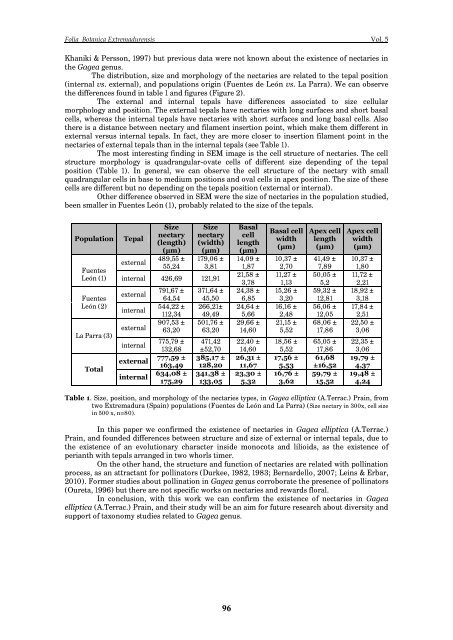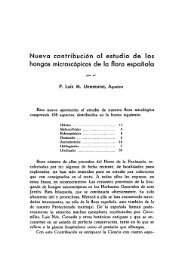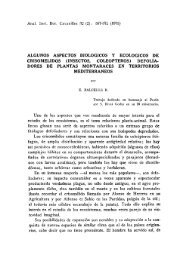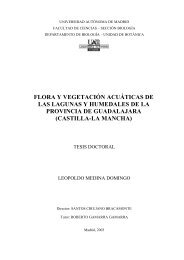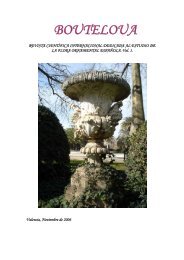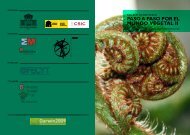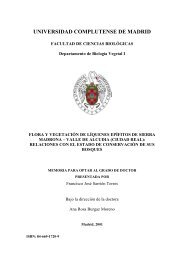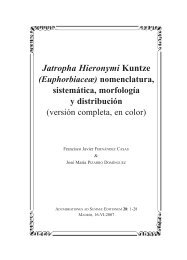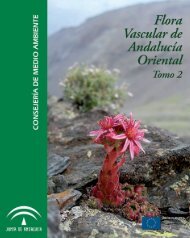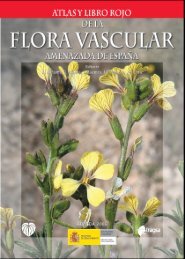Folia Botanica Extremadurensis, vol. 5 (2011) - Biblioteca digital del ...
Folia Botanica Extremadurensis, vol. 5 (2011) - Biblioteca digital del ...
Folia Botanica Extremadurensis, vol. 5 (2011) - Biblioteca digital del ...
- No tags were found...
Create successful ePaper yourself
Turn your PDF publications into a flip-book with our unique Google optimized e-Paper software.
<strong>Folia</strong> <strong>Botanica</strong> <strong>Extremadurensis</strong> Vol. 5Khaniki & Persson, 1997) but previous data were not known about the existence of nectaries inthe Gagea genus.The distribution, size and morphology of the nectaries are related to the tepal position(internal vs. external), and populations origin (Fuentes de León vs. La Parra). We can observethe differences found in table 1 and figures (Figure 2).The external and internal tepals have differences associated to size cellularmorphology and position. The external tepals have nectaries with long surfaces and short basalcells, whereas the internal tepals have nectaries with short surfaces and long basal cells. Alsothere is a distance between nectary and filament insertion point, which make them different inexternal versus internal tepals. In fact, they are more closer to insertion filament point in thenectaries of external tepals than in the internal tepals (see Table 1).The most interesting finding in SEM image is the cell structure of nectaries. The cellstructure morphology is quadrangular-ovate cells of different size depending of the tepalposition (Table 1). In general, we can observe the cell structure of the nectary with smallquadrangular cells in base to medium positions and oval cells in apex position. The size of thesecells are different but no depending on the tepals position (external or internal).Other difference observed in SEM were the size of nectaries in the population studied,been smaller in Fuentes León (1), probably related to the size of the tepals.PopulationFuentesLeón (1)FuentesLeón (2)La Parra (3)TotalTepalexternalSizenectary(length)(µm)489,55 ±55,24Sizenectary(width)(µm)179,06 ±3,81internal 426,69 121,91externalinternalexternalinternalexternalinternal791,67 ±64,54544,22 ±112,34907,53 ±63,20775,79 ±132,68777,59 ±163,49634,08 ±175,29371,64 ±45,50266,21±49,49501,76 ±63,20471,42±52,70385,17 ±128,20341,38 ±133,05Basalcelllength(µm)14,09 ±1,8721,58 ±3,7824,38 ±6,8524,64 ±5,6629,66 ±14,6022,40 ±14,6026,31 ±11,6723,30 ±5,32Basal cellwidth(µm)10,37 ±2,7011,27 ±1,1315,26 ±3,2016,16 ±2,4821,15 ±5,5218,56 ±5,5217,56 ±5,5316,76 ±3,62Apex celllength(µm)41,49 ±7,8950,05 ±5,259,32 ±12,8156,06 ±12,0568,06 ±17,8665,05 ±17,8661,68±16,5259,79 ±15,52Apex cellwidth(µm)10,37 ±1,8011,72 ±2,2118,92 ±3,1817,84 ±2,5122,50 ±3,0622,35 ±3,0619,79 ±4,3719,48 ±4,24Table 1. Size, position, and morphology of the nectaries types, in Gagea elliptica (A.Terrac.) Prain, fromtwo Extremadura (Spain) populations (Fuentes de León and La Parra) (Size nectary in 300x, cell sizein 500 x, n=80).In this paper we confirmed the existence of nectaries in Gagea elliptica (A.Terrac.)Prain, and founded differences between structure and size of external or internal tepals, due tothe existence of an e<strong>vol</strong>utionary character inside monocots and lilioids, as the existence ofperianth with tepals arranged in two whorls timer.On the other hand, the structure and function of nectaries are related with pollinationprocess, as an attractant for pollinators (Durkee, 1982, 1983; Bernar<strong>del</strong>lo, 2007; Leins & Erbar,2010). Former studies about pollination in Gagea genus corroborate the presence of pollinators(Oureta, 1996) but there are not specific works on nectaries and rewards floral.In conclusion, with this work we can confirm the existence of nectaries in Gageaelliptica (A.Terrac.) Prain, and their study will be an aim for future research about diversity andsupport of taxonomy studies related to Gagea genus.96


